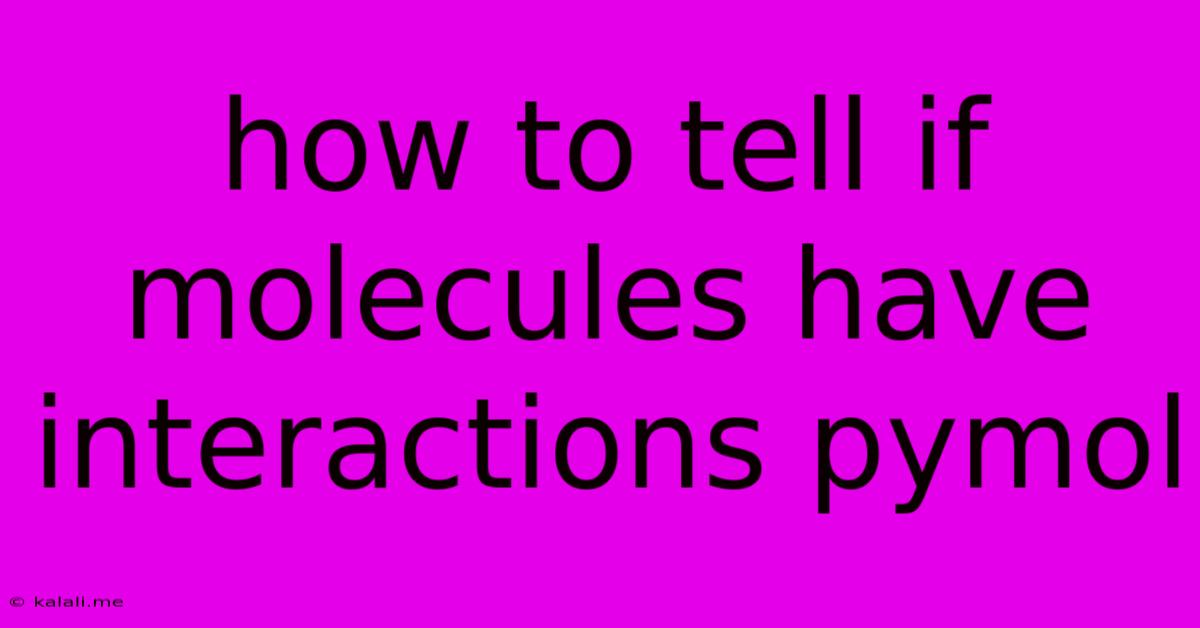How To Tell If Molecules Have Interactions Pymol
Kalali
Jun 02, 2025 · 3 min read

Table of Contents
How to Tell if Molecules Have Interactions in PyMOL
PyMOL, a powerful molecular visualization system, allows you to not only visualize molecules but also analyze their interactions. Understanding how molecules interact is crucial in many fields, from drug design to protein-protein interactions. This article will guide you through several methods to identify and analyze molecular interactions within PyMOL. This includes visualizing hydrogen bonds, hydrophobic interactions, and other crucial non-covalent bonds.
Identifying molecular interactions is a key aspect of structural biology and computational chemistry. This guide will explain how to use PyMOL's features to effectively visualize and understand these critical interactions.
Identifying Hydrogen Bonds
Hydrogen bonds are prevalent and essential interactions in biological systems. PyMOL offers several ways to highlight them:
-
Using the
findcommand: Thefindcommand allows for a more targeted search for hydrogen bonds. You can specify parameters like distance cutoffs to refine your search. For example,find hbondswill identify and display hydrogen bonds. Experiment with different parameters to fine-tune the results based on the specific molecules you are studying. -
Using the "Actions" menu: Navigate to the "Actions" menu, then select "Find" and then "Hydrogen bonds." This offers a simpler, user-friendly approach. This method typically utilizes default parameters, which may need adjustment for specific use cases.
-
Visual Representation: Once identified, PyMOL allows you to customize the visual representation of hydrogen bonds. This could involve changing the bond color, thickness, or even the style of the representation (e.g., dashed lines). This customization can improve readability and enhance the understanding of the interaction's spatial arrangement.
Visualizing Hydrophobic Interactions
Hydrophobic interactions, while not bonds in the traditional sense, are critical driving forces in protein folding and molecular association. PyMOL doesn't directly identify hydrophobic interactions like it does hydrogen bonds. However, you can infer them through visualization:
-
Surface Representation: Generating a surface representation of your molecules (using the
show surfacecommand) allows you to visualize areas of hydrophobicity and hydrophilicity. Hydrophobic patches will appear as regions where the surface is less accessible to the solvent. -
Coloring by Hydrophobicity: PyMOL can color the molecule's surface or atoms based on hydrophobicity, which helps to identify clusters of hydrophobic residues that may indicate hydrophobic interactions. This coloring scheme usually uses a rainbow scale or similar gradient to visualize the hydrophobic interaction areas.
-
Combining with other analysis techniques: Often, using a hydrophobicity coloring scheme in conjunction with other techniques like hydrogen bond identification provides a more complete picture of the interaction. This approach allows for better interpretation of complex molecular structures and interactions.
Analyzing Other Non-Covalent Interactions
Besides hydrogen bonds and hydrophobic interactions, other non-covalent forces significantly influence molecular interactions. While PyMOL doesn't have dedicated tools for all types, you can still deduce their presence through careful observation and the use of various visualization tools:
-
Salt Bridges: Look for close proximity between oppositely charged residues (e.g., lysine and glutamate). PyMOL's coloring options can highlight charged atoms, making identification easier.
-
π-π Stacking: These interactions involve aromatic rings positioned parallel to each other. Visual inspection is often the best approach here, with careful examination of aromatic ring orientations in the 3D structure.
-
Van der Waals Interactions: These weak interactions are ubiquitous but difficult to visualize directly. You can infer their presence based on the overall packing of molecules and the proximity of atoms.
Advanced Techniques
For a more sophisticated analysis, you might consider:
-
Using plugins: Several PyMOL plugins extend its functionality, offering advanced tools for interaction analysis. Explore the PyMOL wiki and plugin repositories for possibilities.
-
Integrating with other software: PyMOL often integrates with other molecular modeling software which can provide additional analytical tools and data not directly available in PyMOL.
-
Custom scripts: Writing custom PyMOL scripts can automate the analysis process and enhance visualization. This option requires basic scripting knowledge, but offers significant flexibility.
By employing these techniques, you can effectively use PyMOL to understand the intricate network of interactions that govern molecular behavior. Remember that context is key; interpreting interactions always requires a solid understanding of the molecules and their biological context. Careful visualization and analysis within PyMOL will provide valuable insights into these complex molecular events.
Latest Posts
Latest Posts
-
How To Tell When Your Propane Tank Is Empty
Jun 04, 2025
-
1997 Chevy S10 Tail Light Fuse
Jun 04, 2025
-
How Do You Address Two People In An Email
Jun 04, 2025
-
How Much Electricity Does A Pc Use
Jun 04, 2025
-
How To Remove Someone From A Slack Channel
Jun 04, 2025
Related Post
Thank you for visiting our website which covers about How To Tell If Molecules Have Interactions Pymol . We hope the information provided has been useful to you. Feel free to contact us if you have any questions or need further assistance. See you next time and don't miss to bookmark.